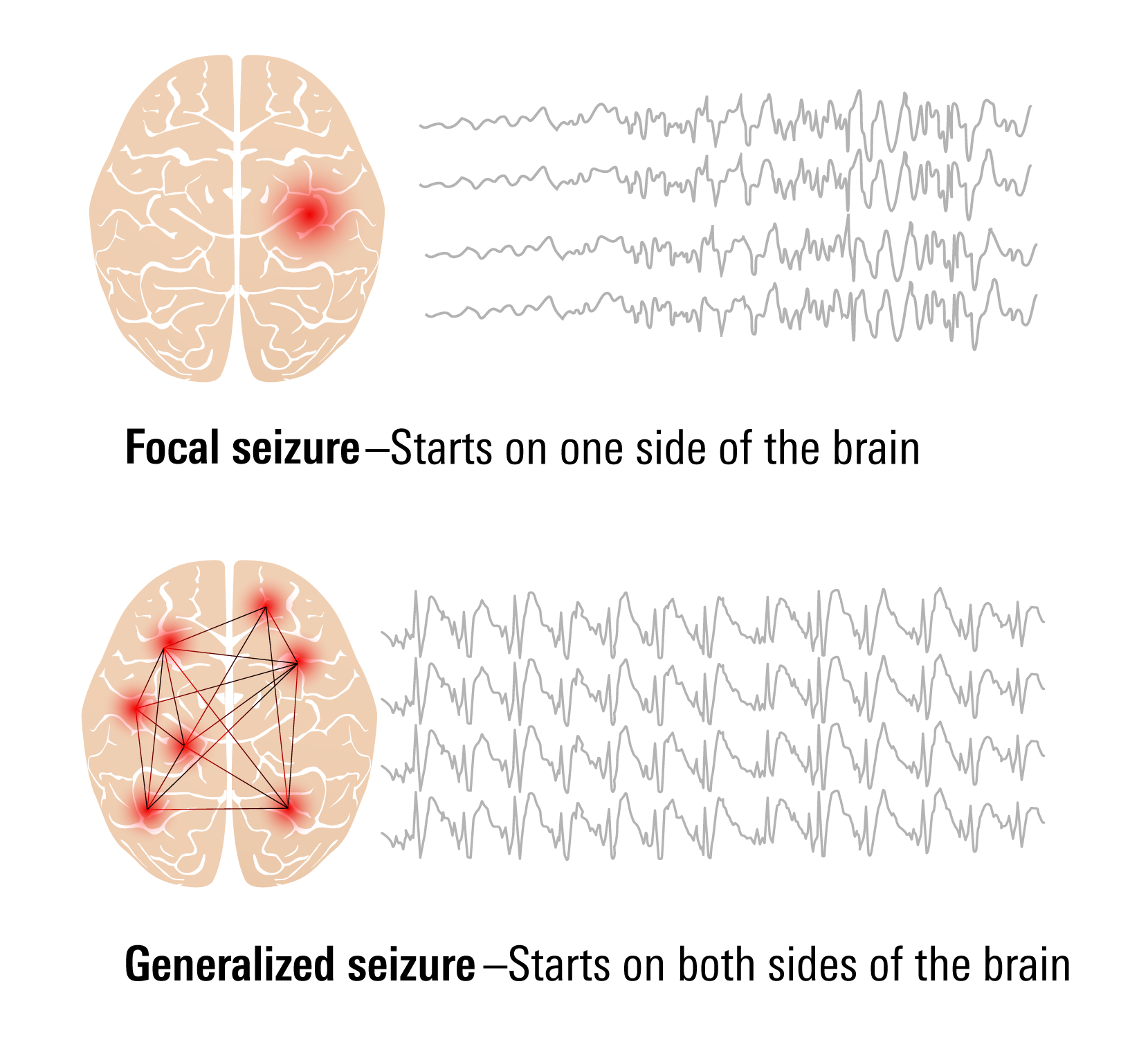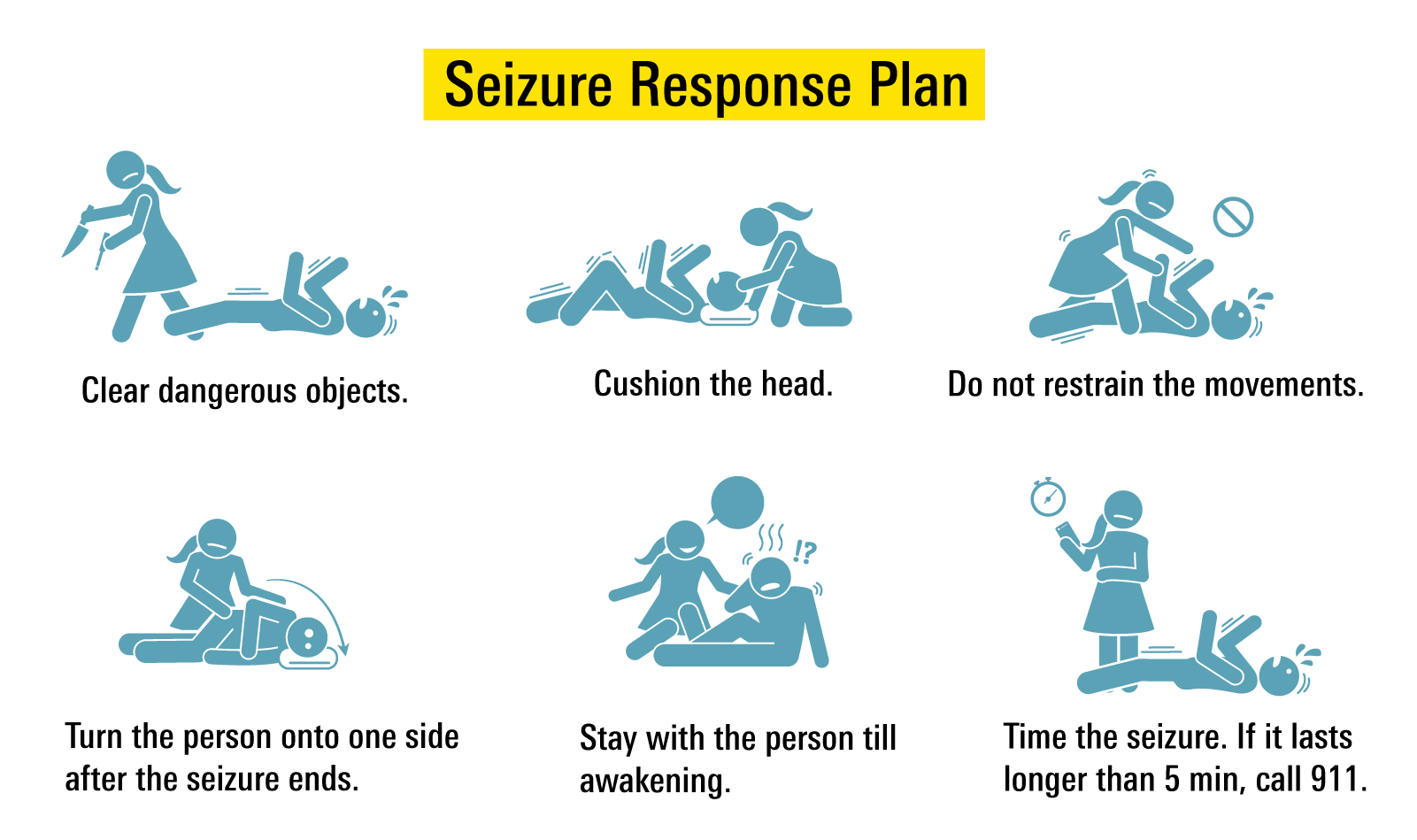Types of Seizures
Each year, epilepsy affects an estimated 5 million people worldwide. Learn how to react to seizures in various circumstances and be equipped to deal with any situation.
What is a Seizure?
A seizure occurs when excitatory neurons produce a sudden surge of electrical activity in your brain. Your demeanor, movements, feelings, and levels of consciousness may all change as a result.
Seizures can be caused by temporary conditions such as fever (most common in children), infection, alcohol withdrawal, hypoglycemia (deficiency of glucose in your bloodstream), or electrolyte abnormalities; in these cases, treating the underlying cause stops the seizure.
What is Epilepsy?
Epilepsy, also referred to as a seizure disorder, is a brain disorder that causes chronic (long-term/ reoccurring) seizures. This condition consists of having 2 or more unprovoked seizures that occur more than 24 hours apart. There are various types of seizures, and multiple medications used to treat them. Seizure medications are called anti-epileptic drugs (AEDs) or anti-seizure medications (ASMs).
Not all seizures are the result of epilepsy. Although brain damage or a genetic predisposition may be related to seizures, the exact cause is frequently unknown.
Who is Affected by Epilepsy?
Car accidents, gunshot wounds, and other causes of severe head trauma can damage your brain, and in some instances trigger seizures. Emergency room treatment for severe head injuries often includes seizure prophylaxis or treatment.
How Are Seizures Diagnosed?
Individuals with epilepsy are evaluated for the age of onset, seizure type, seizure frequency, description of witnessed seizure, identifiable causes or triggers, and a thorough neurologic (brain and brain function) exam.
The most common test used to diagnose epilepsy is an electroencephalogram (EEG), which records electrical activity in your brain. An EEG can show abnormal patterns even when the individual is not having a seizure.
Brain imaging with a CT or MRI can identify some conditions that can provoke seizures, including brain tumors or damage from a stroke.
What Are The Different Types of Seizures?

Seizure types are classified into 3 main types based on where the seizure starts in your brain:
1. Focal seizure:
Focal seizures, also referred to as partial seizures, start on one side of your brain but can spread to the other side.
An individual may initially have a few modest symptoms, known as an aura. You may have altered emotions or perceive impending events (premonition). A rising sensation in your stomach, similar to the feeling of riding on a rollercoaster, is what’s commonly described as an aura.
This type of seizure is further classified based on the individual’s awareness during the seizure:
Focal onset aware seizure: If a focal seizure results in no loss of consciousness, it is called a focal aware seizure.
Symptoms may include:
- Changes in your senses, such as how things taste, smell, and/or sound
- Changes in your emotions
- Seeing flashing lights, experiencing a tingling sensation, and/or feeling dizzy
- Uncontrolled muscle jerking, typically in your arms and/or legs
Focal onset impaired awareness seizure: If an individual experiences loss of consciousness, it’s called a focal seizure with impaired awareness.
Symptoms may include:
- Repetitive movements, such as eye blinking, chewing motion, smacking lips, and/or hand rubbing or finger motions
- Blank stare, also known as “staring into space”
2. Generalized seizure:
Generalized seizures start on both sides of your brain. Individuals with generalized seizures experience loss of consciousness or are aware during the seizure.
The 6 types of generalized onset seizures include:
1. Absence seizure
- Individuals experiencing an absence seizure tend to have a temporary loss of awareness, as well as “stare into space,” otherwise known as a blank stare.
- Children are more likely to have this type of seizure.
- Absence seizures often linger for fewer than 10 seconds and are mistaken for daydreaming.
- Minor muscular movements like eye blinks, chewing or lip-smacking motions, hand motions, or finger rubbing may occur.
2. Atonic Seizure
- Individuals experiencing an atonic seizure develop an unexpected loss of muscle strength and control.
- During this seizure, which generally lasts less than 15 seconds, your head or certain body parts may droop or drop, or you may even lose your balance and fall.
3. Clonic seizure
- Repeated jerking movements of your arms and legs on one or both sides of your body, along with numbness or tingling are the hallmarks of clonic seizures.
- Your muscles may jerk continuously for up to a minute or your muscles may tighten followed by jerking for up to 2 minutes.
4. Tonic seizure
- When you have a tonic seizure, your muscular tone has significantly increased. You may fall if your back, arms, legs, or entire body is strained or stiff.
- Individuals may be conscious or experience a slight change in consciousness throughout this short seizure (usually lasts less than 20 seconds).
5. Tonic-clonic seizure
- An individual’s muscles may tense as well as twitch or jerk during a tonic-clonic seizure.
- When most people hear the word "seizure," they picture tonic-clonic seizures. Your muscles jerk and stiffen for one to five minutes before you pass out and collapse to the ground. You might drool, bite your tongue, and lose control of your bladder or bowels, causing you to urinate or poop.
6. Myoclonic seizure
- During a myoclonic seizure, you may experience brief, jerking spasms of a muscle or muscle group.
- Myoclonic seizures usually last only a couple of seconds.
3. Unknown onset seizure
Seizures are classified as unknown onset seizures if the location of the beginning of the seizure is unknown. If no one witnesses or notices the onset of a seizure, as can be the case when it occurs at night or in a person who lives alone, it may also be referred to as an unknown onset.
First Aid For Seizures

The goal of first aid for seizure is to keep the individual that’s experiencing the seizure safe until the seizure stops naturally. The majority of seizures last between 30 seconds and 2 minutes.
- Prevent injury by clearing the area around the person of anything hard or sharp.
- Ease the person to the floor and put something soft and flat, like a folded jacket, under their head. Turn the person gently onto one side. This will help keep the airway clear.
- Remove eyeglasses and loosen ties or anything around their neck that may make breathing difficult.
- Time the seizure. If the seizure continues for longer than 5 minutes without signs of slowing down, or if the person has trouble breathing, appears to be injured, in pain, or has an unusual recovery, call 911.
- Do not hold people down or try to stop their movements.
- Contrary to popular belief, it’s not true that people having a seizure can swallow their tongue. Do not put anything in the person’s mouth.
- Do not attempt artificial respiration except in the unlikely event that a person does not start breathing after the seizure has stopped.
Speak With Your Doctor
The majority of seizure disorders are treatable with medicine, yet seizure control can still have a big influence on your everyday life. The good news is that you may talk with your doctor to find a balance between medication side effects and seizure management.
Talk to your healthcare provider and send your prescription to Marley Drug. Save up to 95% compared to your local pharmacy by using Marley Drug.
Learn about seizure medications.